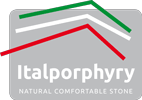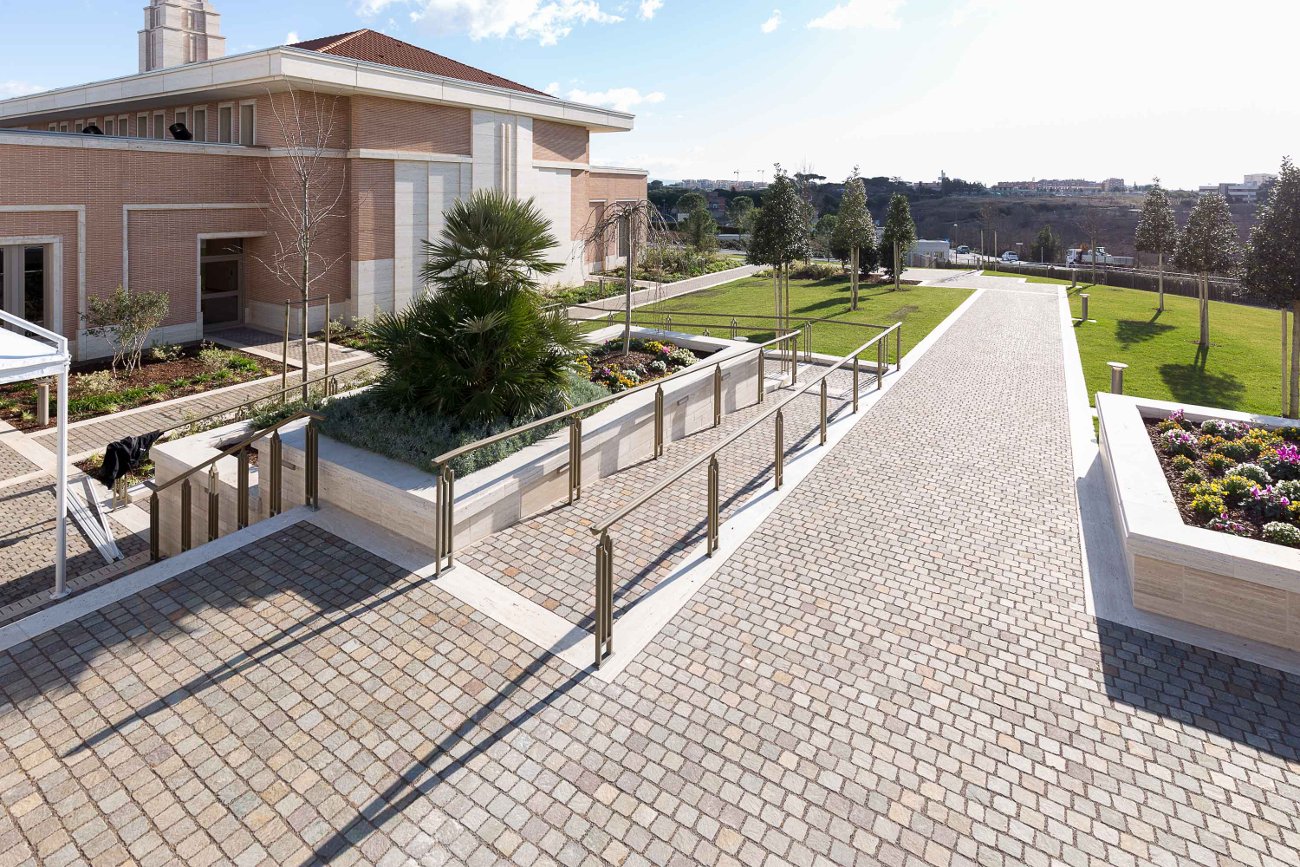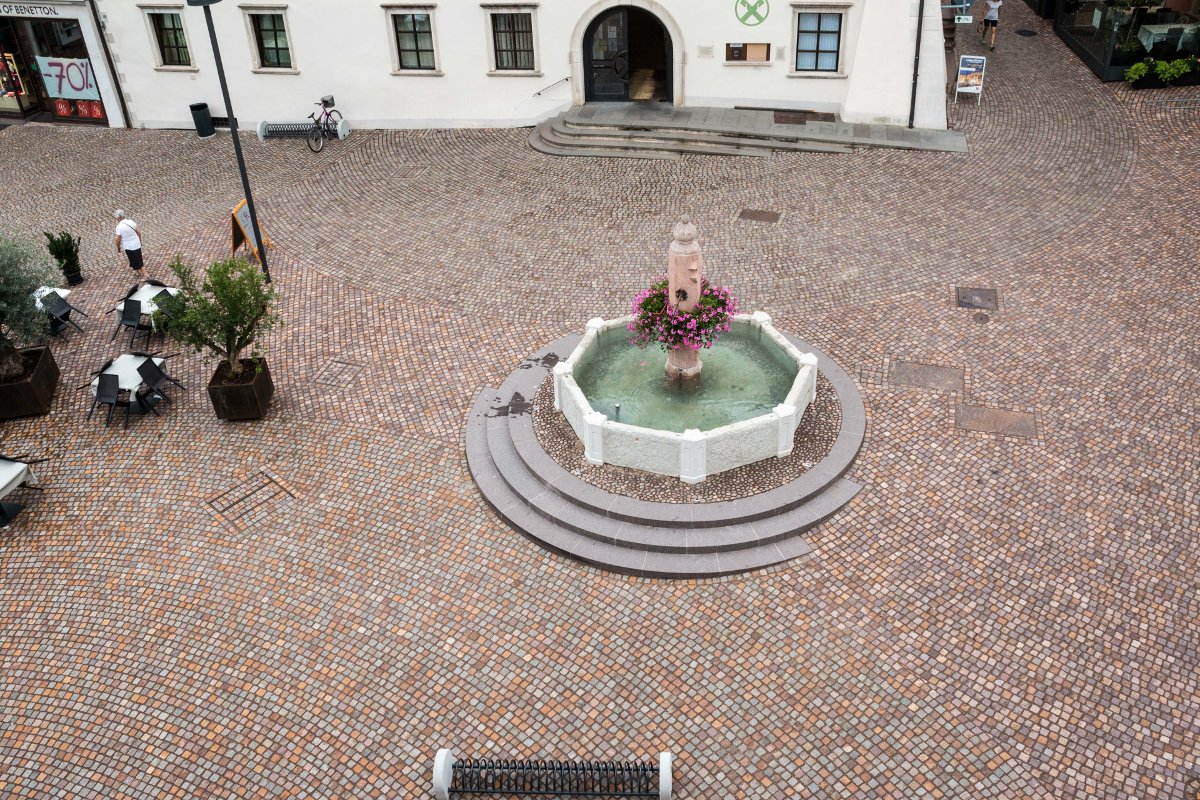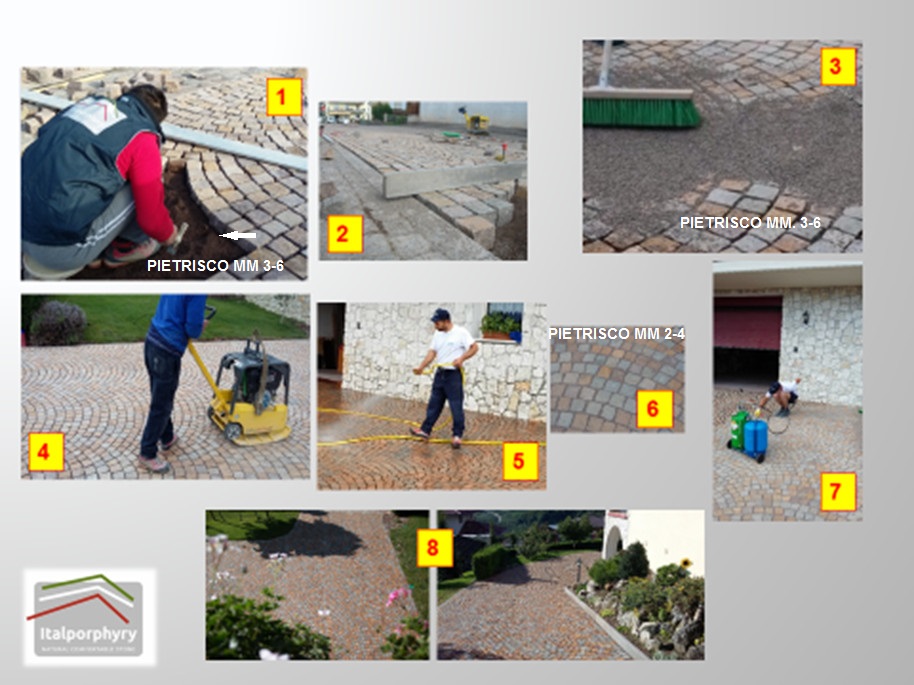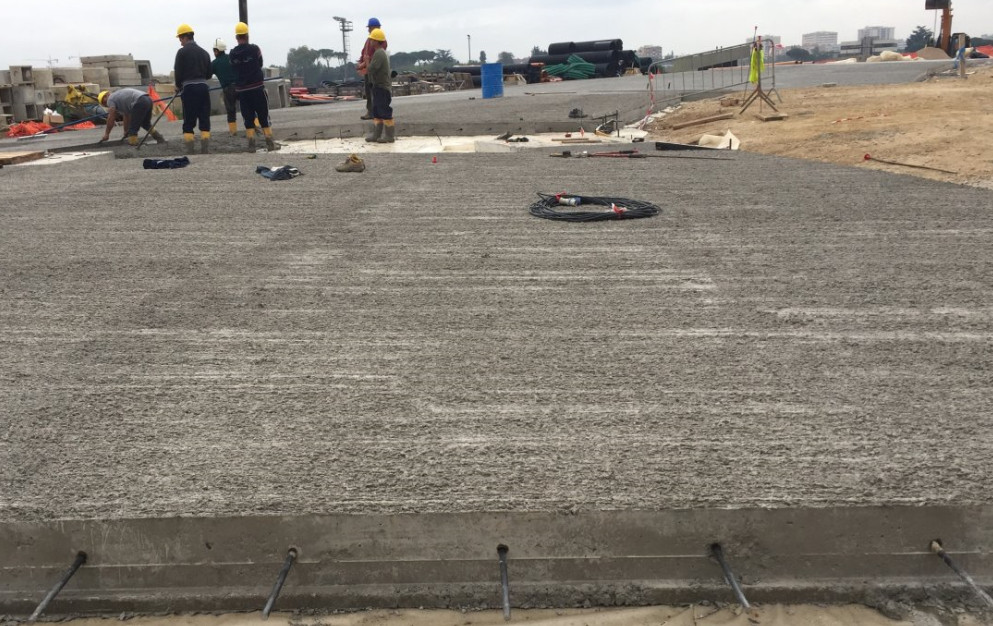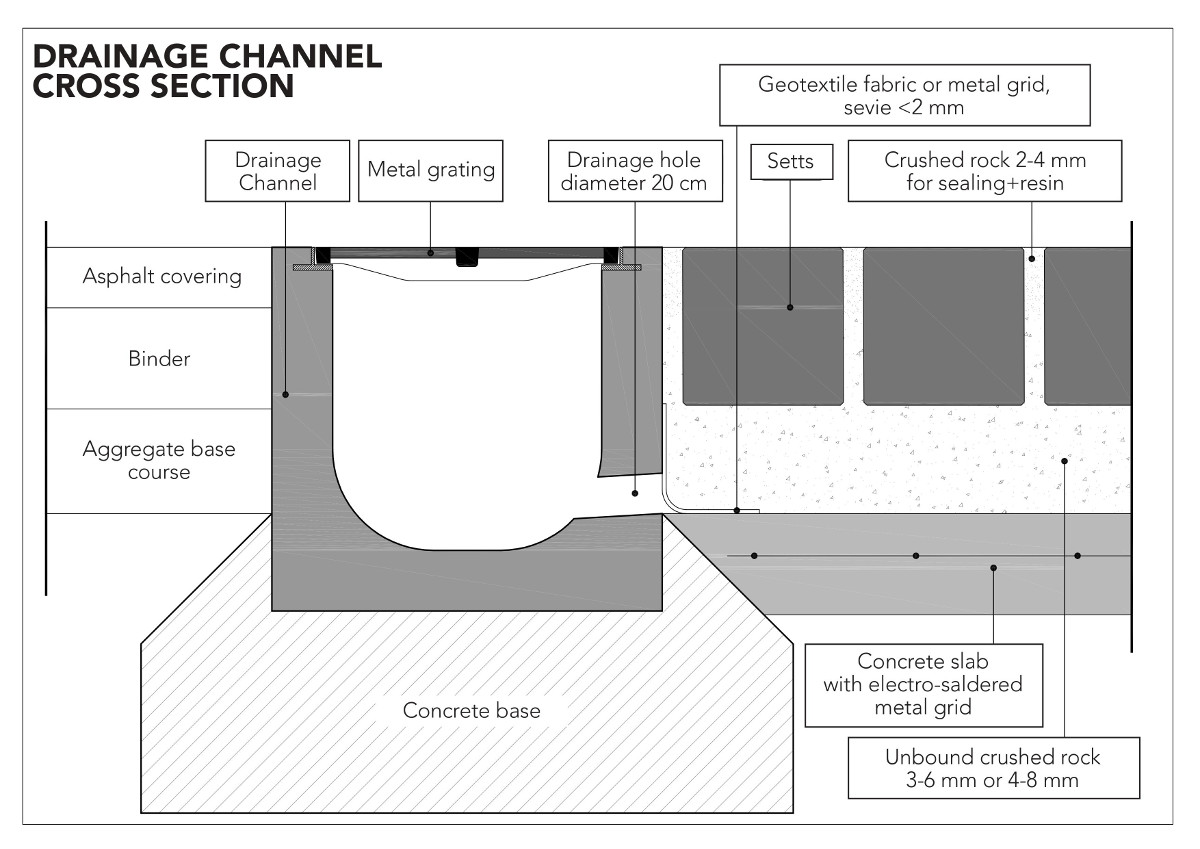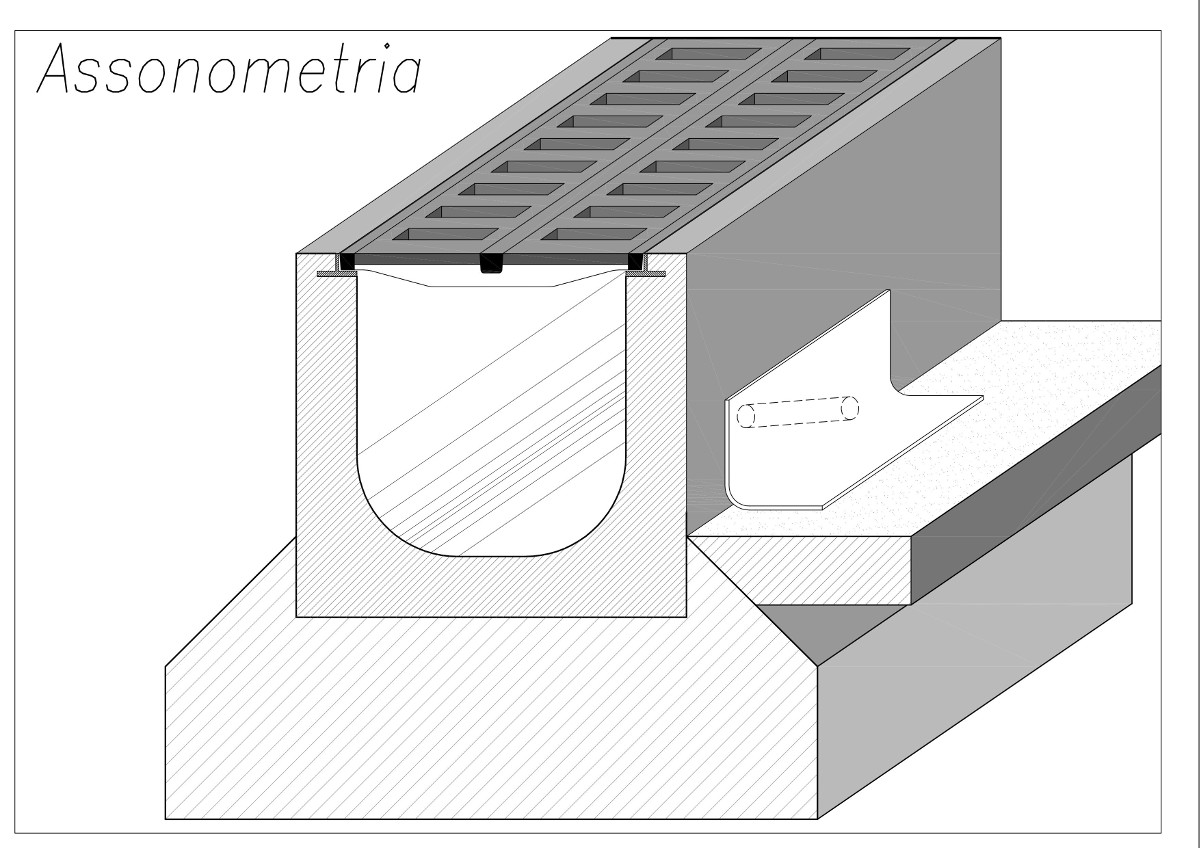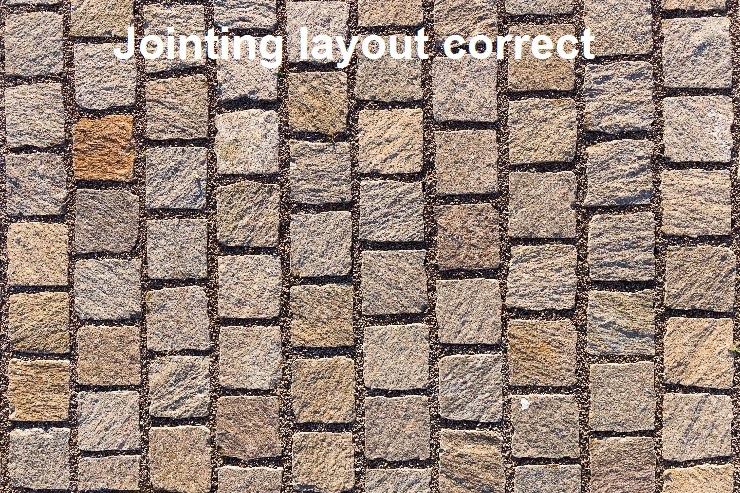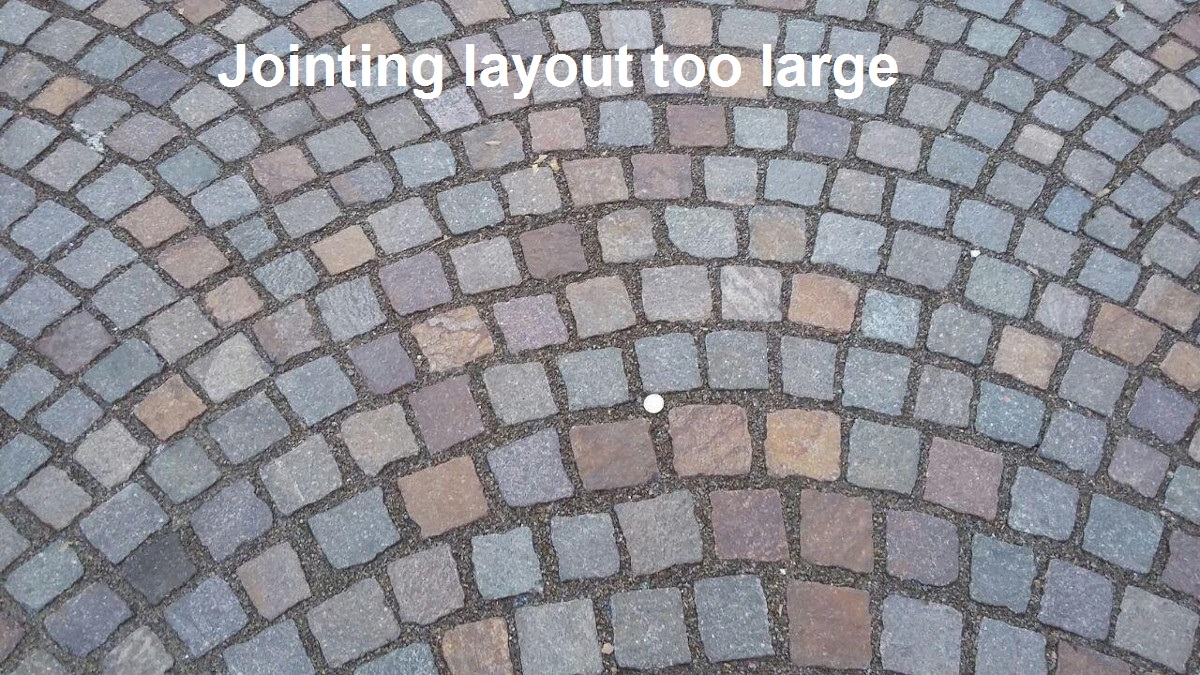POLYURETHANE RESIN FOR PORPHYRY PAVING
WE’LL TELL YOU EVERYTHING YOU WANTED TO KNOW
by Andrea Angheben, technical director
-
-
- A brief history of resin
- What is polyurethane resin for sealing stone paving
- Why is it important to know what polyurethane resin is made of and how it is made?
- Mapestone Joint, the polyurethane resin produced by Mapei, compared to similar products
- When and how Mapestone Joint is used
- What are the best supports for polyurethane resin paving
- What precautions to take when using polyurethane resin
- What are other aspects that make Mapestone Joint better than other products?
- What cannot be expected from polyurethane resin
- Complete specification item.
- Sale and assistance
A brief history of polyurethane resin
When we talk about floor paving using <strong>permeable</strong> cubes with a <strong>polyurethane resin</strong> coating of the porphyry cube joints, it is natural to refer mainly to the public sphere and to requalification and decorative projects of the urban scene.</p> <p>In fact, in the last few years, this particular stone paving laying system has attracted great interest even in private residential spaces, both for the intrinsic properties offered in terms of resistance and functionality, as well as for the very pleasant aesthetic result.</p> <p>And in fact, the “>the most intense type of traffic (type P9).
-
On the other hand, the lack of development and preparation, in the past few years, of adequate or sufficient technical support documentation on the subject (technical sheets and safety data sheets) essential for designers and construction workers, has ended up granting too much discretion not only to producers but also to porphyry laying companies.
This resulted in an influx of “sly” people and unscrupulous entrepreneurs in the field, who in some cases have affected the performance and durability of the product, also compromising the safety of the construction workers involved.
The revision of the UNI standards
This circumstance was noticed first by the UNI work table, responsible for the revision of the UNI 11322-2009 standard. Until that moment the technical standard, as far as polyurethane resin sealing is concerned, was limited to giving few indications: “… it is carried out only on paved and compacted pavement and only in the case of lodging in crushed rock; the resin is manually poured into each joint with special equipment. In the case of heavy vehicular traffic, it is preferable to use elastic seals (for example polyurethane resin)”.
In July 2018 the new technical regulatory document UNI 11714-1 envisaged and codified the materials and procedures required for porphyry pavements sealed in polyurethane resin, thus resolving what could be called a partial and dangerous regulatory gap in the matter.
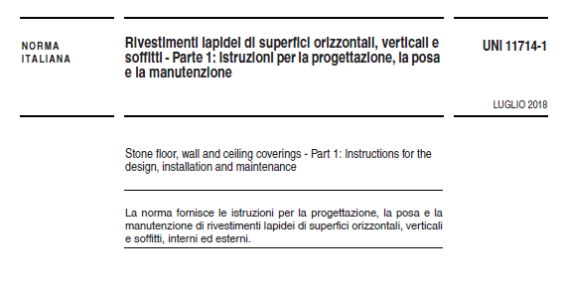
The following standard: UNI 11714-1:2018 “Stone coverings of horizontal and vertical surfaces and ceilings – Part 1, Design, laying and maintenance instructions”, covers polyurethane resin in what is identified as a loose-bed system. Polyurethane resin is recommended for stress classes P4; P5; P6; P7; P8. For class P9, i.e. for urban roads, roads with a lane for public transport or with obligatory routes, high-speed roads, roundabouts, and speed bumps, polyurethane resin is even prescribed.
In essence, the standard establishes that in addition to cement-based premixed products, polyurethane resin is the best material to support vehicle traffic.
Obviously, even the “loose-bed system with resin” must comply with all of the standard’s requirements, among which those of safety, sustainability and durability are of particular relevance.
– The collaboration with Mapei
It is precisely in this context and with these objectives that in 2017 the Italporphyry partnership with Mapei s.p.a. was born. A collaboration in the laboratory and on the field, which led to the development of Mapestone Joint resin. This is a product made by the Research and Development department of Mapei, which involves more than 200 experts every day, and which has found in Italporphyry the ideal partner in offering the expertise and experience to the Mapei researchers for the final improvement of Mapestone Joint, both in terms of performance, reliability and safety.
In this regard, it is important to note that the product is primarily characterized by the absence of solvents and therefore the absence of flammable components. Therefore, there is no danger when storing, transporting or using the product on construction sites.
This is one of the many reasons why Mapestone Joint found immediate appreciation from workers and experts alike. As an example, Italporphyry used Mapestone Joint to seal more than 40,000 square meters of surface on public and private construction sites in the year 2018.
-The search for new products
The work ethic that guaranteed the creation of Mapestone Joint is the basis for the operational criteria that led to laying the foundations for another revolutionary product in the field of permeable paving, towards the end of 2018. It is called “SLAB” by Mapei and it is a system that allows to mix crushed stone in suitable granulometry with Mapestone Joint and obtain an elastic and permeable pavement, which is linked to the laying bed. For this reason, it is applicable to the stress classes P4, P5 and P6 provided by UNI 11714-1.
Currently, SLAB has been used to lay pavements, using slabs or tiles on a loose base of crushed rock (without vibration compaction) with subsequent resin sealing. These are non-standard floors, with a P4 stress class. Therefore, this system has been used mainly for private/residential paving.
What is polyurethane resin for sealing stone paving?
Polyurethane resin and in particular Mapestone Joint is a single-component, solvent-free, non-flammable polyurethane binder. It is transportable without any contraindication and prescribed by the UNI 11714-1 standard for permeable and elastic paving. It is distinguished by resisting de-icing salts, thermal stresses and acids. The paving sealed with Mapestone Joint is sound absorbent and can be reopened to traffic in very short times, within 48 hours of its application in normal temperature conditions.
Mapestone Joint, like all chemical substances, complies with the requirements and is registered according to the REACH Regulation (European Community). That is a precise European regulation that serves to improve the protection of human health and the environment from the risks of chemical substances, stimulating at the same time the competitiveness of the European chemical industry in this regard. It should be remembered that the authorities have the power to impose various restrictions on the use of chemicals. In the long term, the most dangerous substances must be replaced with less dangerous substances. It is the companies’ responsibility, in compliance with the REACH regulation, to identify and manage the risks that can be linked to the substances that are produced and sold in the European Union. REACH is therefore a regulation that helps to eliminate the presence of improvised producers and requires compliance with strict rules, with full protection of users and the market in general.
This is one of the reasons why the first formulation of Mapestone Joint already envisaged a isocyanate diluent base to replace toxic solvents. And precisely for these reasons, other producers who sold products
containing acetone as a solvent are trying to follow the virtuous example of Mapei by replacing a percentage of the flammable and noxious solvent with homologous thinners. It is therefore clear that Mapei’s system is a good example that competing producers must follow if they want to continue generating revenue.
Why is it important to know what polyurethane resin is made of and how it is made?
The first polyurethane resins placed on the market (about 15 years ago), proposed a formulation consisting of an isocyanate base with an important variable percentage (15-40%) of added solvent (ex. acetone). This solvent activates the harmful components present in the isocyanate, causing health risks caused by the inhalation of these volatile components by the workers (if not protected by specific devices) but also by “sensitive and/or allergic” persons who are in the construction site area. Therefore, the risk to health and safety was an important factor to consider.
Initially, but unfortunately partly still today, sometimes formulations had different concentrations of the main ingredients, prepared according to the period or the season. For example, the percentage of solvent increased with lowering temperatures and/or increasing humidity, i.e. in the winter it was possible to find mixtures with up to 40% of solvent. This means a total alteration of the performance properties of the resin, but also a lowering of the production costs of the resin, to the advantage of the seller and to the disadvantage of the purchaser. A similar example could be taken from the wine industry: what value would a bottle of “Amarone” wine have, if it had been diluted by a ratio of 3:2 (60% wine and 40% water)? We can therefore understand how the quality of these resins in the past was altered, without adding any further details.
The importance of SDS (safety data sheets)
The careful reading of Safety Data Sheets is an indispensable aspect for all public or private clients, designers and construction work supervisors. A distinctive element of Mapestone Joint is complete transparency: the Technical Data Sheet and the Safety Data Sheet are easily downloadable from the web.
On the contrary, it is not known why other producers or distributors demand the user to register in the reserved areas of their websites to access documents that should be in the public domain.
Moreover, if there are several improbable “seasonal and customized” formulations of polyurethane resin, there should be as many different Technical Sheets and especially different Safety Data Sheets. But in reality, with the exception of Mapestone Joint, the opposite is mostly true.
REACH underlines the fact that subjectivity in the field of chemicals cannot be tolerated. And the awareness of this circumstance should be well known not only to designers and construction work supervisors, but also obviously to porphyry installers and companies involved in paving work.
Mapestone Joint, the Mapei resin compared to competing products
As already mentioned in the points above, we reiterate that Mapestone Joint is made by Mapei using a specific reactor, based on a precise and unique formulation using high quality materials. Mapestone Joint therefore has only one Safety Data Sheet. The production always follows the original rules and variations are not tolerated, unless these changes and/or improvements are registered on a new SDS.
The uniqueness of the SDS allows all operators involved (designer, construction work supervisor, contractor, installer, but also those responsible for the procedure and safety, as well as transporters, law enforcement, etc.) to have the complete certainty of the properties of material that is used, moved or transported.
The presence of diluent in place of solvents allows the classification of Mapestone Joint as a “non-hazardous” substance for transport. For the same reasons the material is not flammable.
On the other hand, the presence of solvents in other competing products, recognizable also by the typical smell of varnish, can make the substance flammable, especially when the solvent is present in a high percentage. This alters the safety when using, handling, storing and transporting the product. In any case, all the standard individual protection measures established by law are always recommended.
When and how Mapestone Joint is used
As anticipated, Mapestone Joint is recommended for stone paving subjected to vibratory compaction with plate compactor, such as cubes, binders, pebbles starting from the stress class P4 up to the extreme P9, which includes heavily stressed roads, roundabouts, and bus preferential lanes.
The following images describe the main procedures to be followed for a correct flooring sealed with polyurethane resin:
- Laying of the paving on a bed of magmatic crushed rock (gravel 3-6 mm or 4-8 mm);
- Maintenance of the pre-compacting level of stone;
- Filling joints with magmatic crushed rock (3-6 mm);
- Vibratory compaction with plate compactor and controlled water jet (or dry);
- Surface light washing;
- When the pavement and crushed rock bed are dry, stone elements are filled a second time with dry special and selected magmatic crushed rock (gravel 2-4 mm);
- Sealing with resin and special equipment;
- Final result
NB: in case of resin spillage on the paving it is possible to perform fresh-on-fresh cleaning with CLEANER Mapei. This product contains thinners and therefore does not contain flammable elements and is not dangerous for transport, handling or storage.
What are the best supports for polyurethane resin paving?
Regarding the preparation of the support surface, there are no particular indications regarding the ideal typology. Currently, a considerable part of the pavements finished with this sealing system have given excellent results in the presence of a concrete slab shaped according to the finished paving and in respect of possible slopes. In this context, and given the partially draining characteristic of the product, it is useful to provide drainage points in correspondence of the areas of accumulation or stagnation of water on the support surface: for example, by making some holes or slots next to storm drains or already present linear rain water ducts, that can be protected using non-woven geotextiles or metal sheets with adequate drainage. In any case, there is nothing to prevent the use of cylindrical macadam support, cemented mix or draining concrete.
What to pay attention to if using polyurethane resin
The polyurethane resin, being an isocyanate based chemical, is sensitive to humidity. The Mapestone Joint SDS specifies that before starting the sealing phases it is necessary to ensure oneself that the laying bed in magmatic stone is sufficiently dry. Therefore, in case that a vibratory compaction of paving with water, it is strongly recommended to wait for the necessary amount of time for it to dry. The crushed rock itself must be dry and clean as well. For this reason, the material must be laid not long before the actual resin treatment is carried out.
And for the same reason, in the case of cylindrical macadam support or stabilized soil (where it is easier to find pockets of residual humidity, especially after rainfall) it is necessary to pay maximum attention to this.
-Watch out for the temperatures!
Furthermore, it is recommended to avoid sealing with polyurethane resin in the early morning hours, while on the contrary there are no contraindications if the operations are managed during the hottest hours, even at very high temperatures and/or in windy conditions. Resin has therefore exactly the opposite properties of what conditions the sealing phases with cement grouting. However, the intrinsic characteristics of polyurethane resin show that in some periods of the year the use of this sealing system determines the need to evaluate the operating and meteorological conditions to correctly program the sealing phases. It is not possible to describe the solutions to be adopted according to the different circumstances, but it is clear that starting from the late autumn season, resin sealing must always be carefully planned, also evaluating the consequences in case the construction work must be halted.
-… And also pay attention to the vibrating plate!
Vibratory compaction is a strategically fundamental operation for the durability of paving sealed with polyurethane resin. Provided that the installation takes place with pre-compacting level, the compaction must be carried out with equipment suitable for the type of stone. So, with 4/6 cubes it is advised to use a plate compactor with a minimum power of 15-18 kN, with cubes 6/8, a power of 25-30 kN, with cubes 8/10, a power of 30-40 kN, and so on. In any case, once the compaction is complete it is always advisable to maintain a pavement level a few millimeters above the finished height, especially next to thresholds, perimeter strips and fixed points, in order to allow for the natural settlement that the elastic paving will undergo following intense vehicular traffic. For the same reason, the laying bed (gravel/crushed rock) must have physical mechanical performances similar to those offered by porphyry (Los Angeles test <20), to avoid problems of pulverization and consequent weakening of the laying bed over time. No specific skills are required to use the product. The correct use is linked to a short training period needed to know the characteristics and properties of the product, the paving technique, as well as the methods for managing the necessary equipment. The quantity of resin to be distributed in the joints must be such as to avoid spillage along the surface of the laid stones as much as possible, since any imperfections can only be removed before hardening, using the Mapei Cleaner. It is not easy to remove the product once it has hardened. The expected average consumption is 1 kg per square meter.
- It is not subject to the formation of grass or mosses.
- Is resistant to interventions carried out with sweeper machines suitable for the type of stone.
- It is sound absorbent.
- It does not need expansion joints and at the same time limits the absorption of heat compared to paving made with a cement system.
What are the other characteristic and performing aspects of Mapestone Joint?
The traffic re-opening times are contained within 24 – 48 hours in normal weather conditions. The polyurethane resin might require more time to harden in different temperature conditions from the optimal ones indicated in the technical data sheet. Every building material must be able to dry properly. Thanks to the Mapestone Joint system, it is possible to manage some delicate construction phases in a better way. For example, to respond to the needs of logistics and traffic along the main roads, it is possible to divide the roadway into two portions, as in asphalt paving: with an alternating one-way direction, first one side of the roadway is paved; then that first side is opened to traffic and the construction workers can proceed with the laying and resining of the second portion of the roadway. With Mapestone Joint, the point of contact at the center of the road between the two portions made at different times will not present micro-cracks or laying cracks, which are common in the case of cement-based paving. This also allows for restoration operations with excellent aesthetic and functional results at any time. The paving is draining (as regulated by UNI EN 12697 – 40), and at the same time elastic, resistant to de-icing salts, acids and sea spray.
What you can’t expect from polyurethane resin
The excellent performance offered by polyurethane resin has led some operators to believe that the product is the ultimate solution for all ills. This is not true!
A polyurethane resin paving, to offer the best performance, must first be performed following all the executive procedures provided for by the UNI standard (11714-1:2018) and by the technical manuals of the sector.
This means:
- that, as we have described above, the support soil must be shaped respecting the necessary thicknesses;
- that the stone and the support bed (cubes) are of a suitable type to withstand the different stress classes;
- that the installation is carried out according to the manual;
- that the pre-compacting level and the subsequent vibratory compaction are managed according to the expected operating procedures;
- that, basically, the pavement is already in a perfect condition before being sealed with polyurethane resin.
On the contrary, recently there have been too many cases in which the laying of the elements occurs with excessively wide grout lines, and in any case with an overall texture and joint dimensions which is not suitable to guarantee the normal resistance of the paving. If it is preferable that the cubes do not touch each other in order to allow the percolation of the resin in the grout lines, it is equally true that the task of guaranteeing final resistance cannot be entrusted solely to the sealing resin. In other words, the overall structure must avoid the possible loosening of the individual cubes before sealing. The images shown below illustrate two different cases.
– Item specifications
PAVING IN PORPHYRY CUBES WITH SEALING OF GROUT LINES USING POLYURETHANE RESIN – stress class P9
Supply and installation of paving in Trentino porphyry following the characteristics of the Trentino Controlled Porphyry Italporphyry brand, made using small cubes with a natural quarry upper surface and mechanically split lateral sides, laid in contrasting arches (or parallel rows) on a bedding layer consisting of crushed magmatic rock, cleaned and dried in a suitable grain size (3/6 mm) and a correct thickness of maximum 5/6 cm.
Once the cubes have been laid, the interstices must be filled with the same inert draining material, followed by the normal filling phase and mechanical vibration with plate compactor.
Then the grout lines must be filled with small crushed rock of the same grain size (or better with a granulometry of 2/4 mm), which must be perfectly clean and dry. Subsequently, it is possible to apply the Mapestone Joint polyurethane resin, compliant with the requirements and registered according to the Reach Regulation (CE), which shall be poured in each grout line manually with a system consisting of a controlled pressure cylinder (maximum 3 bar) with low risk of any violent leaks.
The polyurethane resin used must be free of solvents and flammable substances, with a characteristic smell, and suitable for disposal or recycling according to the regulations in force on non-hazardous special waste, supported by documentation with official certificates. When mixed with the sealing gravel, the polyurethane resin must provide precise indications of conductivity and draining permeability according to the provisions of UNI EN 12697 – 40. The porphyry material must be supplied with a Declaration of Performance and CE marking, as required by regulation 305/2011, and by UNI EN 1342, with updated performance data. The price includes the costs for the supply and installation of the bed layer, the formation of the necessary slopes for the disposal of rainwater, the simultaneous compaction by means of an adequate mechanical plate vibrator, the possible replacement of broken or deteriorated cubes in the course of work, sealing the interstices with resin and anything else necessary to complete the work in accordance with the technical standard UNI 11714-1 for stress class P9.
Cube sizes cm …
Notes:
- The Regulation of the Trentino Porphyry Controlled Brand, referred to in all the items of the Price List LL.PP. of the Province of Trento, is a voluntary system born in 1995 with the intention of providing certainties for the quality of the material to public and private designers and clients. It is a product brand, not a corporate one, and it is obtained through periodic production checks carried out by specialized personnel with the preparation of result reports available to those who request them.
- With a resolution of the Provincial Council n. 2051 of October 19th, 2018, the requirements of the new Trentino porphyry and stone quality product brand have been approved, currently awaiting imminent implementation. The requirements of the new product brand expressly recall the contents of the voluntary brand of 1995 and its subsequent modifications. The Italporphyry companies adhere to the regulation.
- The crushed rock to be used in the laying bed must have a Los Angeles test value <20%. From this point of view, Trentino porphyry is an ideal stone, as are other magmatic rocks such as granite and basalt.
- Mapestone Joint is a product that complies with the requirements of the REACH Regulation (CE). The product is registered by Mapei spa and is currently the only isocyanate-based resin introduced on the market to contain diluent instead of solvent for the protection, safety and health of users. The solvent (which is not present in Mapestone Joint) would activate the harmful components of the isocyanate, creating an inhalation risk.
- The European standards on stone materials obligatorily require that the stone is always accompanied by the Declaration of Performance with indications for traceability. The rule also requires the regular renewal of technical tests, every two or ten years.
- The reference to the plate compactor is essential to ensure maximum compaction of the pavement (in porphyry cubes). For example, in the case of 8/10 cubes the minimum weight of the compactor is about 200 kg – 30 kN or 350 kg – 40 kN)
- The UNI 11714-1: 2018 standard “Stone coatings of horizontal, vertical surfaces and ceilings – Part 1 Instructions for design, installation and maintenance”, was prepared by the members of the GL 20 Paving and stone cladding of the UNI Commission/CT 033 – Products, processes and systems for the building organization. The work group is made up of natural stone producers and products for its installation and maintenance, trade associations, test laboratories, universities, and design services.
- The stress class P9, according to UNI 11714-1: 2018 identifies: urban roads, roads with preferential lanes for public transport or with fixed routes, intense-traffic roads, roundabouts, hills and speed bumps.
Sale and assistance
Italporphyry provides the expertise and professionalism of its staff in the consulting and purchase phase of the product, dedicating all the time that the customer deems necessary for the correct use of the materials. But of course Italporphyry will always be present even in the construction and after-sales assistance phase. At Italporphyry you can get Mapestone Joint in the most suitable packaging for the needs of your working site: 25 kg cans; 200 kg drums up to 1000 kg tanks (the latest subject to previous order). You can also buy the Mapestone Joint Cleaner in the 5 liter cans.
Please contact us for more infomations regarding prices for resin and injector kit rental costs.
